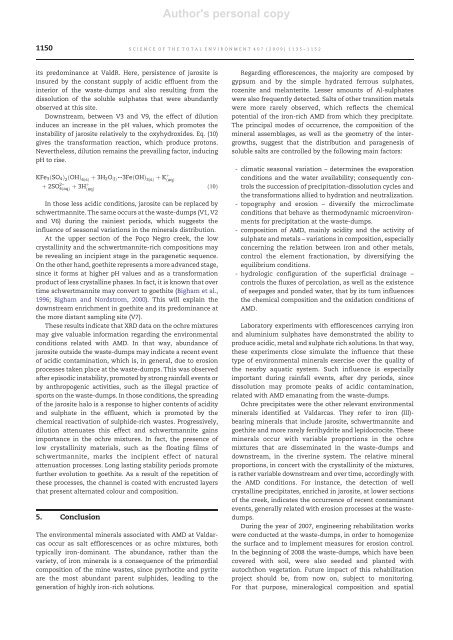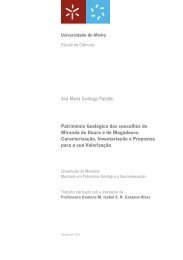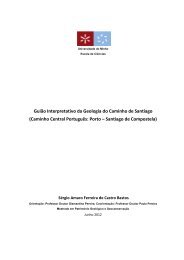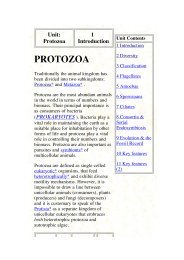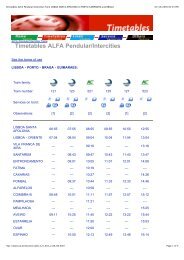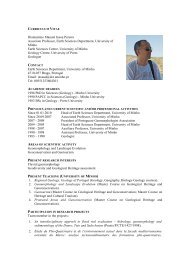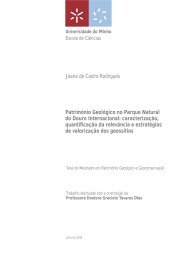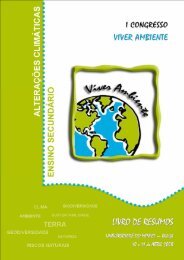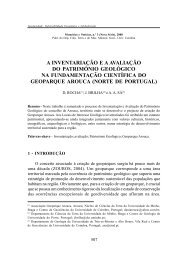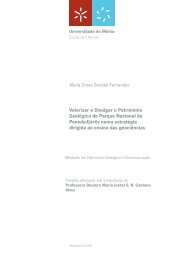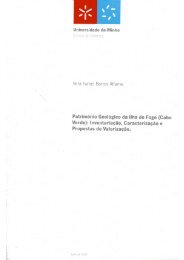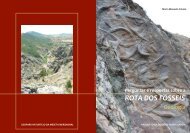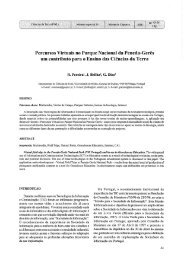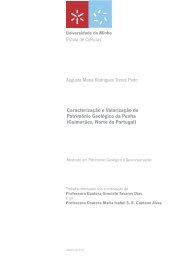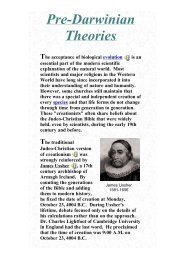Descarregue o Livro do Curso a partir daqui - Departamento de ...
Descarregue o Livro do Curso a partir daqui - Departamento de ...
Descarregue o Livro do Curso a partir daqui - Departamento de ...
Create successful ePaper yourself
Turn your PDF publications into a flip-book with our unique Google optimized e-Paper software.
Author's personal copy<br />
1150 SCIENCE OF THE TOTAL ENVIRONMENT 407 (2009) 1135– 1152<br />
its pre<strong>do</strong>minance at ValdR. Here, persistence of jarosite is<br />
insured by the constant supply of acidic effluent from the<br />
interior of the waste-dumps and also resulting from the<br />
dissolution of the soluble sulphates that were abundantly<br />
observed at this site.<br />
Downstream, between V3 and V9, the effect of dilution<br />
induces an increase in the pH values, which promotes the<br />
instability of jarosite relatively to the oxyhydroxi<strong>de</strong>s. Eq. (10)<br />
gives the transformation reaction, which produce protons.<br />
Nevertheless, dilution remains the prevailing factor, inducing<br />
pH to rise.<br />
KFe 3 ðSO 4 Þ 2<br />
ðOHÞ 6ðsÞ<br />
þ 3H 2 O ðlÞ ↔3FeðOHÞ 3ðsÞ<br />
þ K þ ðaqÞ<br />
þ 2SO 2−<br />
4ðaqÞ þ 3Hþ ðaqÞ<br />
ð10Þ<br />
In those less acidic conditions, jarosite can be replaced by<br />
schwertmannite. The same occurs at the waste-dumps (V1, V2<br />
and V6) during the rainiest periods, which suggests the<br />
influence of seasonal variations in the minerals distribution.<br />
At the upper section of the Poço Negro creek, the low<br />
crystallinity and the schwertmannite-rich compositions may<br />
be revealing an incipient stage in the paragenetic sequence.<br />
On the other hand, goethite represents a more advanced stage,<br />
since it forms at higher pH values and as a transformation<br />
product of less crystalline phases. In fact, it is known that over<br />
time schwertmannite may convert to goethite (Bigham et al.,<br />
1996; Bigham and Nordstrom, 2000). This will explain the<br />
<strong>do</strong>wnstream enrichment in goethite and its pre<strong>do</strong>minance at<br />
the more distant sampling site (V7).<br />
These results indicate that XRD data on the ochre mixtures<br />
may give valuable information regarding the environmental<br />
conditions related with AMD. In that way, abundance of<br />
jarosite outsi<strong>de</strong> the waste-dumps may indicate a recent event<br />
of acidic contamination, which is, in general, due to erosion<br />
processes taken place at the waste-dumps. This was observed<br />
after episodic instability, promoted by strong rainfall events or<br />
by anthropogenic activities, such as the illegal practice of<br />
sports on the waste-dumps. In those conditions, the spreading<br />
of the jarosite halo is a response to higher contents of acidity<br />
and sulphate in the effluent, which is promoted by the<br />
chemical reactivation of sulphi<strong>de</strong>-rich wastes. Progressively,<br />
dilution attenuates this effect and schwertmannite gains<br />
importance in the ochre mixtures. In fact, the presence of<br />
low crystallinity materials, such as the floating films of<br />
schwertmannite, marks the incipient effect of natural<br />
attenuation processes. Long lasting stability periods promote<br />
further evolution to goethite. As a result of the repetition of<br />
these processes, the channel is coated with encrusted layers<br />
that present alternated colour and composition.<br />
5. Conclusion<br />
The environmental minerals associated with AMD at Valdarcas<br />
occur as salt efflorescences or as ochre mixtures, both<br />
typically iron-<strong>do</strong>minant. The abundance, rather than the<br />
variety, of iron minerals is a consequence of the primordial<br />
composition of the mine wastes, since pyrrhotite and pyrite<br />
are the most abundant parent sulphi<strong>de</strong>s, leading to the<br />
generation of highly iron-rich solutions.<br />
Regarding efflorescences, the majority are composed by<br />
gypsum and by the simple hydrated ferrous sulphates,<br />
rozenite and melanterite. Lesser amounts of Al-sulphates<br />
were also frequently <strong>de</strong>tected. Salts of other transition metals<br />
were more rarely observed, which reflects the chemical<br />
potential of the iron-rich AMD from which they precipitate.<br />
The principal mo<strong>de</strong>s of occurrence, the composition of the<br />
mineral assemblages, as well as the geometry of the intergrowths,<br />
suggest that the distribution and paragenesis of<br />
soluble salts are controlled by the following main factors:<br />
- climatic seasonal variation – <strong>de</strong>termines the evaporation<br />
conditions and the water availability; consequently controls<br />
the succession of precipitation-dissolution cycles and<br />
the transformations allied to hydration and neutralization.<br />
- topography and erosion – diversify the microclimate<br />
conditions that behave as thermodynamic microenvironments<br />
for precipitation at the waste-dumps.<br />
- composition of AMD, mainly acidity and the activity of<br />
sulphate and metals – variations in composition, especially<br />
concerning the relation between iron and other metals,<br />
control the element fractionation, by diversifying the<br />
equilibrium conditions.<br />
- hydrologic configuration of the superficial drainage –<br />
controls the fluxes of percolation, as well as the existence<br />
of seepages and pon<strong>de</strong>d water, that by its turn influences<br />
the chemical composition and the oxidation conditions of<br />
AMD.<br />
Laboratory experiments with efflorescences carrying iron<br />
and aluminium sulphates have <strong>de</strong>monstrated the ability to<br />
produce acidic, metal and sulphate rich solutions. In that way,<br />
these experiments close simulate the influence that these<br />
type of environmental minerals exercise over the quality of<br />
the nearby aquatic system. Such influence is especially<br />
important during rainfall events, after dry periods, since<br />
dissolution may promote peaks of acidic contamination,<br />
related with AMD emanating from the waste-dumps.<br />
Ochre precipitates were the other relevant environmental<br />
minerals i<strong>de</strong>ntified at Valdarcas. They refer to iron (III)-<br />
bearing minerals that inclu<strong>de</strong> jarosite, schwertmannite and<br />
goethite and more rarely ferrihydrite and lepi<strong>do</strong>crocite. These<br />
minerals occur with variable proportions in the ochre<br />
mixtures that are disseminated in the waste-dumps and<br />
<strong>do</strong>wnstream, in the riverine system. The relative mineral<br />
proportions, in concert with the crystallinity of the mixtures,<br />
is rather variable <strong>do</strong>wnstream and over time, accordingly with<br />
the AMD conditions. For instance, the <strong>de</strong>tection of well<br />
crystalline precipitates, enriched in jarosite, at lower sections<br />
of the creek, indicates the occurrence of recent contaminant<br />
events, generally related with erosion processes at the wastedumps.<br />
During the year of 2007, engineering rehabilitation works<br />
were conducted at the waste-dumps, in or<strong>de</strong>r to homogenize<br />
the surface and to implement measures for erosion control.<br />
In the beginning of 2008 the waste-dumps, which have been<br />
covered with soil, were also see<strong>de</strong>d and planted with<br />
autochthon vegetation. Future impact of this rehabilitation<br />
project should be, from now on, subject to monitoring.<br />
For that purpose, mineralogical composition and spatial


